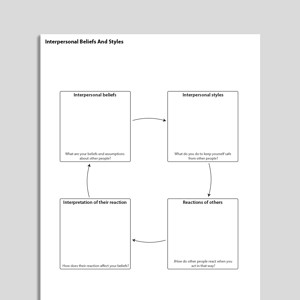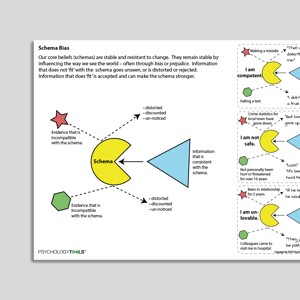Schema Therapy
Schema therapy (ST) is an integrative approach that brings together elements from cognitive behavioral therapy, attachment and object relations theories, and Gestalt and experiential therapies. It was introduced by Jeff Young in 1990 and has been developed and refined since then. Schema therapy is considered an effective way of conceptualizing and treating personality disorders. Rafaeli, Bernstein, and Young (2011) and Jacob and Arntz (2013) describe some of the distinguishing features of schema therapy.
ST places more emphasis than traditional CBT upon the development of current symptoms.
ST emphasizes the therapist–patient relationship and its potential for corrective influence.
ST aims to help patients understand their core emotional needs and to learn ways of meeting those needs adaptively.
ST focuses extensively on the processing of memories of aversive childhood experiences, making use of experiential techniques to change negative emotions related to such memories.
Negative Parenting Styles (Schema Therapy)
Negative Parenting Styles (Schema Therapy)
Early Maladaptive Schemas
Early Maladaptive Schemas
Insufficient Self-Control
Insufficient Self-Control
Dependence / Incompetence
Dependence / Incompetence
Coping Styles And Responses (Schema Therapy)
Coping Styles And Responses (Schema Therapy)
Approval-/Admiration-Seeking
Approval-/Admiration-Seeking
How Your Past Affects Your Present (Schema Therapy)
How Your Past Affects Your Present (Schema Therapy)
Boundaries - Self-Monitoring Record
Boundaries - Self-Monitoring Record
How Trauma Can Affect You (CYP)
How Trauma Can Affect You (CYP)
Interpersonal Beliefs And Styles
Interpersonal Beliefs And Styles
What Is Imagery Rescripting?
What Is Imagery Rescripting?
Unhelpful Thinking Styles (Archived)
Unhelpful Thinking Styles (Archived)
Core Belief Magnet Metaphor
Core Belief Magnet Metaphor
Links to external resources
Psychology Tools makes every effort to check external links and review their content. However, we are not responsible for the quality or content of external links and cannot guarantee that these links will work all of the time.
Assessment
- Young Schema Questionnaire – L2 (YSQ-L2) link
Information Handouts
- List of early maladaptive schemas | Schema Therapy Institute Of South Africa
- List of schema modes | Schema Therapy Institute Of South Africa
Information (Professional)
- A client’s guide to schema-focused cognitive therapy | David Bricker, Jeffrey Young: Shcema Therapy Institute
- An introductory guide to Schema Therapy: adapted for use with the YSQ-R | David Bricker, Jeffrey Young, Ozgur Yalcin | 2023
Presentations
- Using schemas and schema modes as a basis for formulation and treatment planning in schema therapy | David Edwards
Websites
- Handouts & questionnaires for emotions, schema and personality | 2009
Worksheets
- Log book for schema triggering and mode analysis
What Is Schema Therapy?
Assumptions of ST
Everybody has emotional needs that are universal and present from childhood. These needs include: safety, stability, nurturance, acceptance, autonomy, competence, identity, expression, spontaneity, and for a world with realistic limits.
Psychological health is the ability to get one’s needs met in an adaptive manner.
During childhood people develop schemas—broad organizing principles—which help to guide them in making sense of their life and experiences. These are elaborated and developed over the lifespan. Schemas work as ‘shortcuts’—they help us to come quickly to what we think is likely to be true saving us from having to think /process every detail. They are not always accurate.
Some schemas—particularly those acquired from toxic or traumatic childhood experiences where the young person’s needs were not met to a significant degree—are described as early maladaptive schemas and are responsible for difficulties relating to other people, personality disorders, and some mental health problems.
Young, Klosko, and Weishaar (2003) defined early maladaptive schemas as:
a broad, pervasive theme or pattern;
composed of memories, emotions, cognitions, and bodily sensations;
regarding oneself and one’s relationships with others;
developed during childhood or adolescence;
elaborated throughout one’s lifetime; and
dysfunctional to a significant degree.
Four types of life experiences lead to the development of early maladaptive schemas:
when the child’s early environment is missing something important such as love, stability, or understanding;
when the child is harmed or victimized (when the need for safety was unmet) and develops schemas which reflect danger, threat, or pain;
when the child is coddled/indulged/overprotected and did not receive sufficient freedom or autonomy;
when the child selectively identifies with the thoughts, feelings, experiences, and behaviors of an influential adult such as a parent.
Schemas lead us to attend to and remember information that is consistent with the schema, and behaviorally draw us to familiar events and environments. Thus they self-perpetuate.
Early maladaptive schemas become dysfunctional because they lead us to maintain particular types of attachments, relationships, or environments, and because they lead us to perceive situations as toxic/threatening even when they are not.
People tend to cope with their early maladaptive schemas in ways that reinforce them, including:
schema surrender, which involves giving in to ones’ schemas;
schema avoidance, which means avoiding situations or people which trigger our schemas;
schema overcompensation which means doing the opposite of one’s schemas.
Whereas early maladaptive schemas can be thought of as relatively stable traits, schema modes describe emotional states, schemas, and coping relations that are active at a particular time. People are able to switch between modes during their day or week. There are four types of mode:
child modes (the vulnerable child mode is of the focus of therapy);
maladaptive coping modes;
dysfunctional internalized parent modes;
a healthy adult mode which is the part of the self that is capable, strong, and well-functioning.
Types of Early Maladaptive Schemas
Young and colleagues have identified 18 early maladaptive schemas, which can be assessed using the Young Schema Questionnaire (YSQ). They include:abandonment/instability
mistrust/abuse
emotional deprivation
defectiveness/shame
social isolation/alienation
dependence/incompetence
vulnerability to harm or illness
enmeshment / underdeveloped self
failure
entitlement/grandiosity
insufficient self-control/self-discipline
subjugation
self-sacrifice
approval-seeking/recognition-seeking
negativity/pessimism
emotional inhibition
unrelenting standards/hypercriticalness
punitiveness
Procedures and Techniques of ST
Schema therapy involves the task of limited reparenting in which the therapy relationship is one which recognizes, articulates, validates, and (to some extent) fulfils the needs of the patient.
The second ‘central pillar’ of schema therapy is empathic confrontation (Young et al., 2003) in which the therapist empathically, and nonjudgmentally confronts the patient on their maladaptive behaviors and cognitions, emphasizing their self-defeating nature.
Schema therapy case conceptualization is used to describe patient symptoms, identify current triggers, propose mechanisms for the emergence and maintenance of problems, and provides a ‘story’ about how the patients problems might be resolved.
Schema therapy makes extensive use of guided imagery as both an assessment tool, and as a technique for intervention.
Cognitive techniques used within schema therapy include: data collection, reframing/reattribution, schema flashcards and diaries, and schema dialogues.
Emotion-focused techniques used with schema therapy include: role-play / chair work, and guided imagery.
Behavioral techniques used with schema therapy include: rehearsal of adaptive behavior in imagery or role-play, behavioral homework, and rewarding adaptive behavior.
References
Jacob, G. A., & Arntz, A. (2013). Schema therapy for personality disorders—A review. International Journal of Cognitive Therapy, 6(2), 171–185.
Rafaeli, E., Bernstein, D. P., & Young, J. (2011). Schema therapy. CBT Distinctive Features Series. New York: Routledge.
Young, J. E., & Klosko, J. S. (1993). Reinventing your life: The breakthrough program to end negative behavior and feel great again. New York: Dutton.
Young, J. E., Klosko, J. S., & Weishaar, M. E. (2003). Schema therapy: A practitioner’s guide. New York: Guilford Press.




































